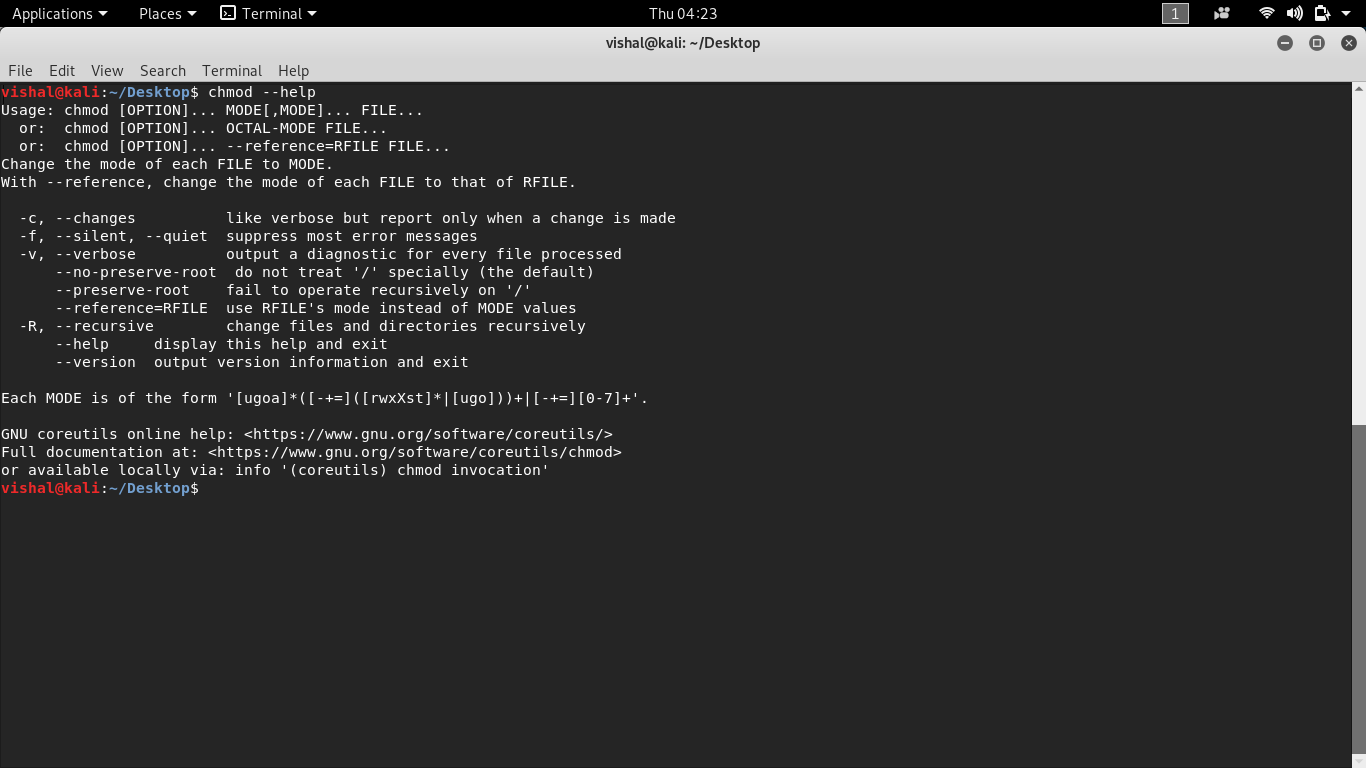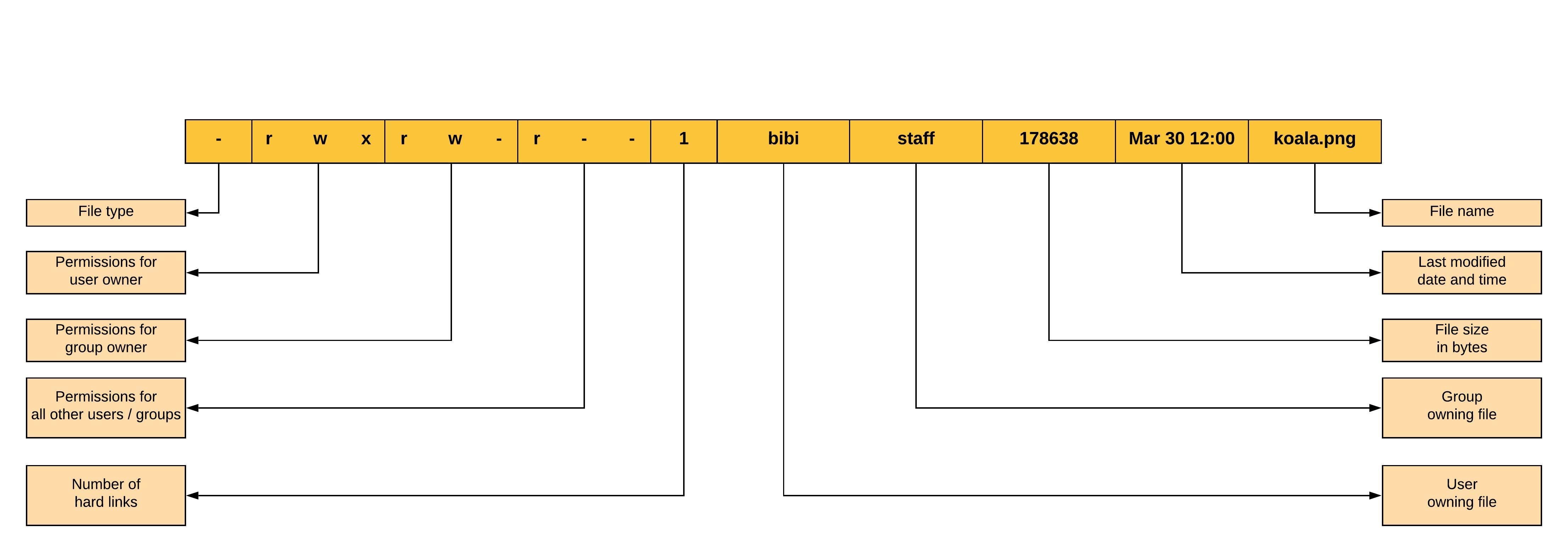The chmod command in various UNIX flavors such as Solaris, Linux, Mac OSX, and others, allows the access controls of a file or directory to be set This techrecipe describes the more complex octal chmod syntax See the techrecipe Set UNIX file access permissions with chmod for the basics of file permissions and chmod ThisDESCRIPTION top This manual page documents the GNU version of chmod chmod changes the file mode bits of each given file according to mode, which can be either a symbolic representation of changes to make, or an octal number representing the bit pattern for the new mode bitsDESCRIPTION This manual page documents the GNU version of chmod chmod changes the file mode bits of each given file according to mode, which can be either a symbolic representation of changes to make, or an octal number representing the bit pattern for the new mode bits

Chmod Mvps Net Blog Mvps Net Tutorials
Chmod octal mode example
Chmod octal mode example-In symbolic mode chmod u=rwx,g=rw,o=rfilesh In octal mode chmod 764 filesh One can also edit an already defined permission with the help of the following operators , and = The following list includes some examples, that illustrate the use of those operators chmod ax filesh or chmod ugox filesh or chmod x filesh allow file to beThe chmod command in Linux is used to change file and directory permissions using either text (symbolic) or numeric (octal) notation It takes the following syntax $ chmod OPTIONS MODE filename Only the root user or a regular user with sudo privileges can change file or directory permissions



How To Manage File Permissions On Ubuntu Server 04 Dev Tutorial
From the (english) man page for chmod (debian jessy) (Highlight by me) A numeric mode is from one to four octal digits (07), derived by adding up the bits with values 4, 2, and 1 Omitted digits are assumed to be leading zerosChange special permissions in absolute mode by using the chmod command $ chmod nnnn filename nnnn Specifies the octal values that change the permissions on the file or directory The first octal value on the left sets the special permissions on the file See Table 176 for the list of valid octal values for the special permissionsPermissions masking with umask, chmod, 777 octal permissions Ian!
Chmod changes the file mode bits of each given file according to mode, which can be either a symbolic representation of changes to make, or an octal number representing the bit pattern for the new mode bitsChmod ( Change Mode ) is a command line utility in Unix , Linux and other Unix like systems to change the read, write, execute permissions of a file for owner , group and others How to use chmod?Description This manual page documents the GNU version of chmod chmod changes the file mode bits of each given file according to mode, which can be either a symbolic representation of changes to make, or an octal number representing the bit pattern for the new mode bits
Please note that chmod 777 filename is the equivalent of chmod 0777 filename in this example The first octal digit sets the setuid, setgid and sticky bits (see this article for more details on setuid/setgid) octal 2 means to set group ID on the file So, the equivalent would be to do a chmod arwx filename, then chmod gs filenameThe chmod info page does explain this in more detailAlso, I like to share a non mathematical approach to find the "mode value" of a desired permission level that can be submitted to a pathlibPathchmod(mode) command Here are the Steps Decide on the permission levels you want for the fileNumeric mode The format of a numberic mode is 'augo' A numeric mode is from one to four octal digits (07), derived by adding up the bits with values 4, 2, and 1 Any omitted digits are assumed to be leading zeros The first digit selects the set user ID (4) and set group ID (2) and sticky (1) attributes The second digit selects permissions



File Permissions In Linux Unix How To Read Write Change



Chmod S
Using chmod in C with octalmode Faça uma pergunta Perguntada hoje Ativa hoje Vista 4 vezes 1 I have an Uni project where I need to use chmod from The part where I use rwx was easy to implement, but the octalmode () is giving me some errors I created a struct and a method to verify the syntax and initiate all theView (u)ser, (g)roup and (o)thers permissions for chmod 621 (chmod arwx,ux,grx,orw) or use free online chmod calculator to modify permissions easily Use the octal CHMOD Command chmod R 621 folder_name OR use the symbolic CHMOD Command After changing a directory's mode to 621 the folder's mode will be displayed in Unix styleChmod is a command line utility that is used for manually managing the access and permissions to files and directories on Linux, Mac, and other Unix like operating systems According to the man page document for chmod "The chmod utility modifies the file mode bits of the listed files as specified by the mode operand


Chmod X Windows Nativeyellow



Net Ftp Network Programming With Perl
Chmod¶ The chmod ("change mode") command is used to change the permission flags on existing files It can be applied recursively using the "R" option It can be invoked with either octal values representing the permission flags, or with symbolic representations of the flags The octal values have the following meaningChmod command is used in two ways 1 Using octal value & position Sets the permission for owner, group and others with octal values , 4 for read , 2 for write , 1 for execute andWhat is chmod ?



Chmod Mvps Net Blog Mvps Net Tutorials



My Personal Notes Linux Notes
A superuser or the file owner can use a chmod command or chmod() function to change two options for an executable file The options are set in two file mode bits SetuserID (S_ISUID) with the setuid option SetgroupID (S_ISGID) with the setgid optionThe chmod utility shall change any or all of the file mode bits of the file named by each file operand in the way specified by the mode operand It is implementationdefined whether and how the chmod utility affects any alternate or additional file access control mechanism (see the Base Definitions volume of POSIX1‐17, Section 45 , FileDESCRIPTION ¶ This manual page documents the GNU version of chmod chmod changes the file mode bits of each given file according to mode, which can be either a symbolic representation of changes to make, or an octal number representing the bit pattern for the new mode bits



Explained How To Use Chmod Command Complete Guide Youtube



Unix Commands Basic To Advanced Unix Commands With Example
Chmod ( Change Mode ) is a command line utility in Unix , Linux and other Unix like systems to change the read, write, execute permissions of a file for owner , group and others How to use chmod?Using octal syntax for chmod allows setting the absolute permissions for owner, group, and other in one quick command The syntax requires three octal digits, each representing the owner, group, and other permissions, respectivelyThis manual page documents the GNU version of chmod chmod changes the file mode bits of each given file according to mode, which can be either a symbolic representation of changes to make, or an octal number representing the bit pattern for the new mode bits



Linux File Permissions And Ownership By Udara Bibile Level Up Coding



Introduction To Unix Fundamental Command Line Commands Ppt Download



0 件のコメント:
コメントを投稿